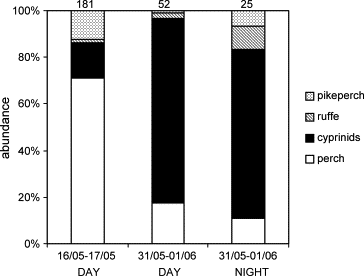 The efficiency of different sized (0.5 m × 2 m, 1 m × 2 m, 2 m × 2 m, 4 m × 2 m) and coloured (black, white) ichthyoplankton trawl nets and the densities of fry between day and night were investigated in the surface stratum of the Římov Reservoir (Czech Republic) during two surveys in mid-May and early June 2007. In mid-May, perch (Perca fluviatilis) was the most abundant fry species in the open water, whereas cyprinids (Cyprinidae) dominated 2 weeks later. Minor fry species in the trawl catches were pikeperch (Sander lucioperca) and ruffe (Gymnocephalus cernua) in both surveys. The comparison of fry densities during day and night revealed significantly higher day densities for the dominant perch and cyprinids, whereas for pikeperch and ruffe significantly higher densities were observed during the night. No significant differences in efficiency and body lengths of the fry sampled were found for any taxa when black and white trawl nets were compared. Comparison of the efficiencies of different sized trawl nets revealed different patterns for the dominant perch and cyprinids during both day and night. For perch, the lowest efficiency was observed for the smallest trawl, whereas the greatest efficiency was observed for the largest trawl net. The efficiencies were significantly different between trawls during day and night only for perch. For cyprinids, the efficiencies of different sized trawl nets were insignificantly different during both day and night. For pikeperch and ruffe similar trends in efficiency of different sized trawl nets were revealed. The lowest efficiency was reached with the smallest trawl but during the day a significant decline in efficiency of the largest trawl was also observed. Our results indicate that for sampling perch fry during both day and night and for sampling ruffe and pikeperch fry, especially during the day, a trawl net with a 1 m2 mouth is not sufficiently efficient. The density of these fry species is significantly under estimated with such small nets. The fry body lengths sampled by different sized trawl nets did not differ significantly.
The efficiency of different sized (0.5 m × 2 m, 1 m × 2 m, 2 m × 2 m, 4 m × 2 m) and coloured (black, white) ichthyoplankton trawl nets and the densities of fry between day and night were investigated in the surface stratum of the Římov Reservoir (Czech Republic) during two surveys in mid-May and early June 2007. In mid-May, perch (Perca fluviatilis) was the most abundant fry species in the open water, whereas cyprinids (Cyprinidae) dominated 2 weeks later. Minor fry species in the trawl catches were pikeperch (Sander lucioperca) and ruffe (Gymnocephalus cernua) in both surveys. The comparison of fry densities during day and night revealed significantly higher day densities for the dominant perch and cyprinids, whereas for pikeperch and ruffe significantly higher densities were observed during the night. No significant differences in efficiency and body lengths of the fry sampled were found for any taxa when black and white trawl nets were compared. Comparison of the efficiencies of different sized trawl nets revealed different patterns for the dominant perch and cyprinids during both day and night. For perch, the lowest efficiency was observed for the smallest trawl, whereas the greatest efficiency was observed for the largest trawl net. The efficiencies were significantly different between trawls during day and night only for perch. For cyprinids, the efficiencies of different sized trawl nets were insignificantly different during both day and night. For pikeperch and ruffe similar trends in efficiency of different sized trawl nets were revealed. The lowest efficiency was reached with the smallest trawl but during the day a significant decline in efficiency of the largest trawl was also observed. Our results indicate that for sampling perch fry during both day and night and for sampling ruffe and pikeperch fry, especially during the day, a trawl net with a 1 m2 mouth is not sufficiently efficient. The density of these fry species is significantly under estimated with such small nets. The fry body lengths sampled by different sized trawl nets did not differ significantly.
Keywords: cyprinids; fry density; length selectivity; Perca fluviatilis; perch; trawl efficiency
